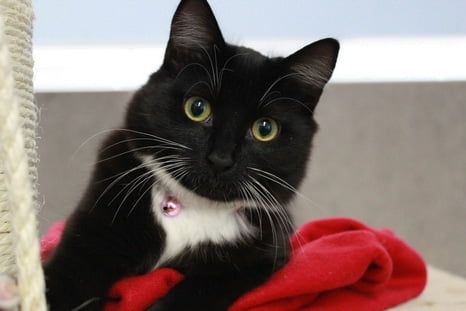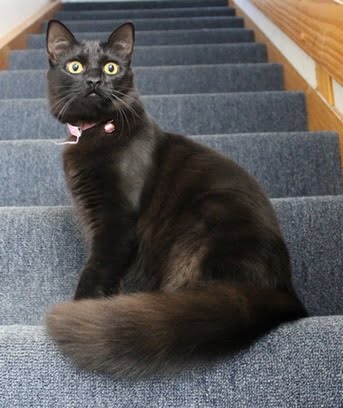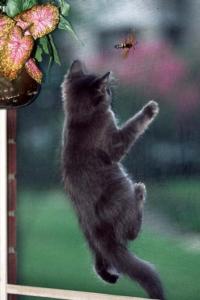
What is the best way to confine a cat when needed?
The first question you should ask yourself regarding confinement of cats is ‘How and where do I confine my cats?’
Cats generally tolerate confinement well. Unlike dogs, cats do not need as much exercise. They exercise isometrically rather than aerobically. This means that, where dogs love to run and romp, cats are content to exercise by stretching and flexing. Cats occasionally get the ‘wind in their tails’ and will race around like buzz-saws with black, dilated pupils resembling dinner plates. Such activity can be easily catered for in a properly designed cat enclosure.
The broad choices are to house the cats either inside the house or outside in an enclosure.
If outside, and you are going to construct an enclosure, you should check with the Council for any building regulations that may be relevant. Ready-made aluminium cages, based on designs used for aviaries, are available. With any cage outdoors, and especially those made of metal, you must ensure that such cages have proper insulation and are always in the shade.
The advantages of metal cages are that they are long lasting, they are easy to clean, and they are impervious, so they don’t harbour disease. Any outdoor cages used to house cats should be constructed on gently sloping concrete pads to promote proper hygiene and allow efficient cleansing. Remember to allow for proper drainage so that it can be hosed out easily.
The disadvantage of outdoor cages is that they separate the pets from their owners. This can be overcome by having the cages adjacent to a window of the house and placing a cat-sized corridor from the window to the cattery. If a cat flap is fitted to the corridor, you then have the choice of allowing the cats inside the house when you (or they) want and it allows you to put them to bed in their cattery when you go to bed yourself. Cat flaps can be purchased in a variety of configurations so that they allow free movement in both directions or so that they allow one-way traffic only.
If you choose to house your cats indoors, you can either allow them access to the whole house or segregate them to one or more rooms of the house.
Many cat owners confine their cats to the laundry, and I have also seen some wonderful cat dens made in patios and verandas. By enclosing a patio with lattice or wire mesh, the cats have an enclosure with an outside vista. They can still do a bit of sun-baking if they desire and from their Puss-Cat Palace can view the passing world with lofty superiority without getting their paws dirty or wet. After all, cats are creatures of comfort.

Another concept I have seen a cat owner use in a third story unit is the provision of a window-box-garden-bed-enclosure attached to the outside of a suitable window. It had shade provided, a small pot of grass and soil and two or three elevated shelves for the cats to sleep and climb on. With a cat flap in the window, the cats had full access to the unit and the window box simultaneously and when the owners needed to go out, they could close the door of the room that sported the window box wonderland so that cats were safely enclosed in just one part of the unit.
There are also several companies that specialize in cat confinement products.
The Catmax enclosures are made from an almost invisible netting that can enclose small verandas or decks or entire gardens. More information is available from www.catmax.com.au.
The Catnip enclosures are constructed of steel modules that can be attached to each other to provide a range of enclosures each attached by tunnels or runs. More information is available from www.catnip.com.au.

What size should a cat cage be?
If you are constructing accommodation for your cats, you need to know what size is suitable.
There should be two components, a sleeping area and an exercise or play area, for any cat accommodation. There are a variety of recommendations for the sizes of cat accommodation, but the most useful come from Britain. These are summarized in the table below: –
| No. Of Cats | Size of Sleeping Area | Size of Exercise Area |
| 1 | 0.85 sq m |
1.7 sq m |
| 2 |
1.5 sq m |
2.3 sq m |
| 3 |
1.85 sq m |
2.8 sq m |
The sleeping areas specified in this table are separate from the exercise areas but there is free communication for the cats between the two. Providing separate, semi-enclosed sleeping areas is a good idea and they are best raised in tiers from the ground.
Cats love climbing and prefer to be elevated. Generally, the higher-ranking cat will occupy the upper tiers from which it will leer at the others while poking its tongue at them.
Sleeping accommodation could be a series of comfortable hammock-like shelves attached to the walls of the enclosures or could be boxes with entry portholes. A mixture of the two would be ideal as the cats can choose where they prefer to sleep.
In the exercise or play area, you should certainly provide environmental enrichment. You will find a tree log is very popular. Rest it against a wall with several branches at the same level as the sleeping quarters. Cats find this a wonderful resource. They climb the log and trot along the branches to their bedrooms. If the tree trunk has bark on it, they will also use that to sharpen their claws.
Confined cats are usually much healthier and live longer than cats that are free to roam, but the enclosures do need to be of good quality to work properly.
